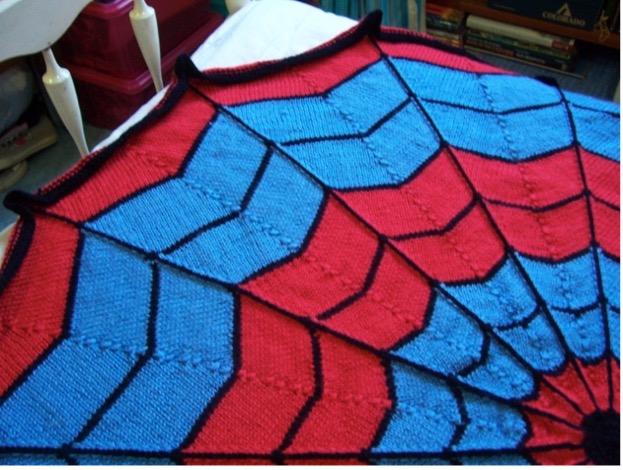If you have been to a comic convention, you might have at one point passed by five different Darth Vaders marching around.
You might have seen Ms. Frizzle, who is still the coolest magic schoolteacher.
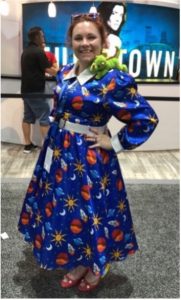
Or, you might have seen two Marios planning the perfect photoshoot.

Whatever the case may be, you are surrounded by hundreds of people dressed up as their favorite characters. All these outfits are examples of cosplay, or the creative practice of dressing up as a specific character (typically fictional).
The Question
Now, what if you decide to start cosplaying? You could end up spending hundreds of dollars, and months on end trying to create the perfect outfit for your Spider-Man cosplay. After all that effort, you begin wondering—are there any intellectual property rights to the cosplay you created with your own two hands?
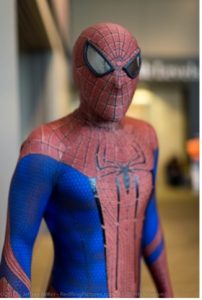
To explore whether your cosplay would have intellectual property rights, I will first discuss what copyright is and what that protects. Afterwards, I will explore the nuances to copyright protections specific to cosplay.
Copyright Basics
Copyright protects a variety of original works of authorship, including pictorial, graphic, and sculptural (PGS) works, that are fixed in a tangible medium with a minimal degree of creativity. PGS works are two-dimensional or three-dimensional artworks by nature, whether that be items like photographs or clothing. However, there are additional caveats to copyright protection, especially for PGS works and derivative works, or works based on other copyrighted works.
To start off, a basic copyright test includes asking yourself whether your work is original, fixed, and has a minimal degree of creativity.
The question of originality is whether it is original to you, the creator. Well, that seems easy enough. You created the Spider-Man outfit with your own two hands, whether that be with your everyday sweats, 3D-printing material, or with craft foam.
The next question is whether your cosplay is fixed. Since the outfit is sufficiently permanent such that it can be perceived for more than a short period of time—the whole convention in fact—the outfit is considered fixed.
The third question is whether the Spider-Man cosplay has a minimal degree of creativity. From the web lines all around the costume to the mask with moving lenses, there is more than enough creativity to go around.
So, does that mean your Spider-Man cosplay is copyright protected? Well, not so fast.
When it comes to cosplay, these simple questions become complicated, fast. Would the Spider-Man outfit be truly original and creative if it is based off someone else’s creation? Not really—that would be considered a derivative work. Furthermore, when discussing PGS works such as clothing, there are copyright barriers that need to be raised.
Limits to IP Protections for Cosplay: Useful Article Doctrine
Let’s first talk about the copyright limitations on PGS works.
While some PGS works simply portray an appearance (e.g., painting) or provide information (e.g., a subway map), others have an intrinsic utilitarian aspect. A “useful article” includes furniture, machinery, dinnerware, and clothing etc. Generally, copyright protection is limited, though not absolute, for items with utilitarian functions because their design is its function.
For example, copyright does not apply to the shape and cut of clothing that relate to the usefulness of the clothing. This extends to other practical elements like pockets, zippers, and necklines etc. In addition, while an everyday item such as a wooden chair is a sculptural work, such design could not generally be copyrighted because its parts (i.e., the legs, the back) function together to provide seating.
This is where the Star Athletica test comes in.
The Star Athletica tests assesses the copyrightability of a useful article through a two-part test. In other words, certain aspects of your costume’s design could be protected if it first passes this test.
You need to determine whether (1) the design can be identified physically or conceptually separate from and is capable existing independent of its utilitarian aspects and (2) the design would qualify as copyright protectable PGS on its own if imagined separately. In other words, ask yourself, “If this design was on a canvas, could I imagine this as a work of art?”
Returning to the Spider-Man cosplay, mentally lift the design from the actual clothing itself and lay it flat on a canvas. This includes the web lines, the spider symbol, and the colors altogether.
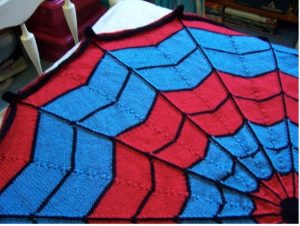
As demonstrated on that beautiful blanket above, you can imagine the Spider-Man costume design as a work of art. Therefore, the pattern can be subject to copyright protections. Going back to that wooden chair we mentioned, if the chair had an ornate back or legs, it could pass the Star Athletica test because the design is an artwork in it of itself.
To be clear, supplemental materials to your cosplay, such as props (i.e., weapons) and other accessories, are still sculptural works, but do not fall under this useful article doctrine. These materials are seen as decorations, rather than functional items that protect or cover our body. For example, masks, which are often used in cosplay, are not considered useful articles because they serve to portray the appearance of something.
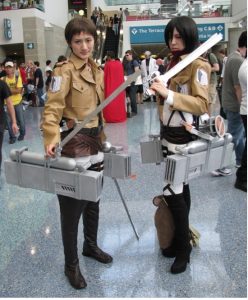
Limits to IP Protections for Cosplay: Derivative Works
Though these accessories might not be denied copyright protection under the useful article doctrine, they might encounter problems because they are copies of previously published works that are protected by copyright—at the end of the day, you must remember who or what you are cosplaying.
Spider-Man has an iconic spider design, which is independently subject to copyright by Marvel—the same goes for many other characters. Costumes of protected characters could be considered derivative works because they are visual depictions based on pre-existing works. So, technically, cosplay could result in copyright infringement since you are referencing works protected by copyright.
However, there is an unspoken agreement between companies and cosplayers to allow cosplaying as it stands. That is why we still see hundreds if not thousands of people cosplaying at a single comic convention.
Therefore, it is important to note that the design of your costume could be protected if it passes both the Star Athletica test and is an authorized derivative work.
The Answer
So, the answer as to whether there are intellectual property rights to your cosplay is… it depends. There are so many factors to consider, which means this question requires more food for thought.
Being a cosplayer is already a major commitment, especially as you are impersonating a character you adore. For the time being, embrace the fun of cosplaying and the (huge) responsibility of being a friendly-neighborhood Spider-Man before you take on this legal undertaking!

Ashton Yeh (they/them)
Associate Blogger
Loyola University Chicago School of Law, J.D. 2025
